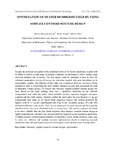Optimization of Oyster Mushroom Yield By Using Simplex-Centroid Mixture Design

View/
Date
2020Author
Kasina, Martin Musembi
Koske, Joseph
Mutiso, John
Metadata
Show full item recordAbstract
Despite the increased recognition of the nutritional value of the Oyster mushroom, coupled with
its ability to tolerate a wide range of climatic conditions, its production is still at infancy stage
with low adoption rate in Kenya. The low uptake could be attributed to lack of skills for
substrates preparations or cost of buying the substrates coupled with poor knowledge on its
consumption benefits. The objective of this study was to optimize Pleurotus ostreatus (Oyster
mushroom) yield by establishing the local suitable substrates mixture that maximized the yield
in Machakos County, Kenya. To achieve this objective simplex-centroid mixture design was
used. Based on the study findings there was a significant variability on the substrate
compositions used under the study, which included sawdust, sugarcane baggase, star grass,
euphoria and the cattle manure. Sawdust yielded the most under the pure blend at 1.1 kg per
experimental unit while on the mixed blend sugarcane bagasse and sawdust produced the
highest yield at 1.3 kg per experimental unit (1kg of dry substrate), giving 10% and 30%
biological efficiency respectively. There was no pinning on the cattle manure and the euphorbia
substrates hence they were eliminated at the screening stage. The mixture response was found
to be more valuable than the pure blend responses then simplex- centroid mixture design to
rightly proportion the substrates was recommended for improved oyster mushroom production.
A further research on determining suitability of alternative locally found substrates which may
be more cost effective and multiple response optimizations aimed at achieving maximal
nutritional value and yield against minimal cost of spawns and substrates were recommended.
